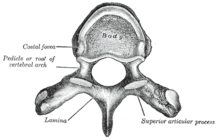Laminectomy
description
The laminectomy is a surgical method on the spine . The vertebral arch with the spinous process is removed from one or more vertebrae in order to gain space for a spinal cord or intervertebral disc operation or to be able to relieve excessive pressure, for example due to a tumor in the vertebral canal.
Since it by this operation to instability phenomena in the spine, especially dislocations can occur, the procedure is usually associated with a spinal fusion performed. A hemilaminectomy is also often performed. After partial removal of one or more spinous processes, only half or part of the vertebral arch or adjacent vertebral arches are removed to expose the spinal cord.
The first laminectomies were performed in 1886 by William Macewen in Glasgow and in 1887 by Sir Victor Alexander Haden Horsley at University College London . War injuries to the spinal cord caused by bullets or bayonet stabs were treated during the First World War under local anesthesia, largely bloodless and after x-ray diagnostics with the surgical instruments available in a field hospital by means of laminectomy.
Individual evidence
- ↑ Wolfgang Miehle: Joint and spinal rheumatism. Eular Verlag, Basel 1987, ISBN 3-7177-0133-9 , p. 174.
- ↑ Heinrich Broerken: About War spinal cord injuries. Univ.-Diss. Berlin, 1920

